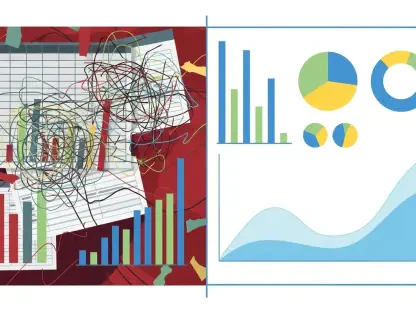Marketing in 2025 requires a reimagined approach to data, media, and content. Marketers must adapt to ever-changing consumer behaviors, cutting-edge technologies, and current market trends. Think of it as cooking in a foreign kitchen—fundamental skills remain unchanged, but new tools and environments necessitate innovative strategies.
Measurement and Insights
Incorporating Diverse Data Sources
First-party data has long been prized by marketers for its ability to build robust customer relationships. However, to truly excel in today’s dynamic market, it is imperative to integrate additional data sources, such as metadata from images used in visual searches and other customer interaction points. This broader array of data not only enriches the understanding of customer behavior but also contributes to crafting a smarter and more nuanced audience strategy.
One prominent trend in modern marketing is the emphasis on harnessing the power of AI to sift through vast data sets and extract meaningful insights. By blending various data streams—from visual search metadata to social interaction touchpoints—marketers can construct a comprehensive view of their audience. This enables them to tailor their campaigns with a precision that wasn’t previously possible, ensuring maximum engagement and conversion rates.
Unified Data Infrastructure
The evolution towards a unified data infrastructure has revolutionized how insights are accessed and employed within organizations. This “data 2.0” era prioritizes real-time analysis, facilitated by advanced AI systems capable of processing large volumes of information swiftly. Gone are the days of periodic data reviews; instantaneous insights now drive timely and informed decision-making across varied departments, from sales to product development.
This advancement democratizes access to data insights, allowing employees at all levels—not just specialized data teams—to leverage this information. The implications are extensive: product managers can make swift adjustments based on customer feedback, sales teams can identify potential leads more effectively, and marketing strategies can be optimized in real-time. This agility accelerates the overall momentum of the organization, fostering a culture of informed decision-making and rapid adaptation to market trends.
Media and Personalization
Adaptable Media Planning
As AI continues to advance, its capabilities in media planning have expanded dramatically. Marketers now possess the tools to target consumers contextually during various activities, including shopping, streaming, scrolling, and searching. Traditional media plans, with their rigid structures, are rendered obsolete in this new landscape, requiring a shift towards more flexible and responsive strategies. AI-driven media planning enables brands to anticipate consumer needs and offer timely, relevant solutions that seamlessly integrate into the consumer’s journey.
The real power of adaptable media planning lies in its ability to enhance the consumer experience through personalized interactions. For example, AI can determine when a consumer is most likely to be receptive to a particular message, ensuring that ads are served when they are most impactful. This context-driven approach not only increases the effectiveness of marketing campaigns but also fosters a deeper connection between the brand and the consumer, enhancing loyalty and driving sustained engagement.
Contextual and Emotional Targeting
Hyper-personalization is the new standard in advertising, and context plays a pivotal role in delivering relevant messages. Ads are no longer generic blasts; they are tailored to individual user contexts and preferences, creating a highly personalized experience. For instance, a dog owner might see an ad for dog treats while visiting a park, whereas someone without a dog might encounter an ad for barbecue equipment under similar weather conditions. This level of customization demands a profound understanding of audience segments and the ability to craft emotionally resonant messages.
Emotion is a powerful tool in advertising, capable of forging strong connections between brands and consumers. Context enables marketers to identify and tap into the specific emotional triggers that resonate with their audience. Whether it’s the joy of a family barbecue or the companionship of a pet, ads that evoke these emotions create lasting impressions. Advanced technologies, including dynamic creative optimization, empower marketers to deliver such personalized and emotionally charged experiences across diverse channels, maximizing the impact of their campaigns.
Creative and Content
Emotional Advertising
In an era where personalization is already deeply embedded in marketing practices, the next frontier lies in emotionally charged campaigns. Emotional advertising transcends basic personalization—such as using a customer’s name or understanding purchase intents—by leveraging storytelling techniques to forge deeper connections with the audience. AI plays a crucial role in this evolution, enabling the creation of compelling narratives and personalized visuals that resonate on a profound level.
The success of emotionally charged advertising hinges on its ability to evoke genuine responses from the audience. By understanding the emotional triggers relevant to specific segments, marketers can craft stories that speak directly to the heart of their consumers. AI-driven tools, such as Demand Gen, facilitate the creation of high-quality, emotionally engaging content at scale, allowing brands to maintain a consistent narrative that aligns with their values and appeals to their audience’s emotions.
The Power of Video
As visual storytelling becomes increasingly central to advertising, video content emerges as a powerful medium for building emotional connections. The ability to convey complex emotions through visuals and sound makes video an indispensable tool in the marketer’s arsenal. The example of László Gaál, a YouTube Creator and digital artist, demonstrates the transformative potential of AI in video production. Gaál’s fully AI-generated homage to Porsche showcases how AI can be used to produce captivating, high-quality content that resonates deeply with audiences.
The strategic use of video content can reinforce brand values, enhance customer engagement, and create memorable experiences. By leveraging AI for video production, brands can produce personalized and emotionally rich narratives at scale, ensuring consistent and impactful storytelling. This approach not only differentiates brands in a competitive landscape but also solidifies their connection with the audience, fostering long-term loyalty and emotional investment.
Keys to Future Success
Marketing in 2025 will necessitate a reimagined approach towards data, media, and content. Marketers will need to flexibly adapt to the ever-evolving consumer behaviors, cutting-edge technologies, and prevalent market trends. Visualize it akin to cooking in a kitchen you’re unfamiliar with. While your basic cooking skills and knowledge remain intact, the introduction of new utensils, appliances, and a different environment would compel you to innovate—finding new strategies and methods to achieve the desired results. Just as one would experiment with unfamiliar spices or techniques to enhance a dish, marketers will similarly need to adopt creative solutions and leverage modern tools to stay ahead. This future landscape will require a blend of time-tested tactics and fresh perspectives, ensuring that marketing campaigns are both relevant and effective. The essence of marketing remains the same, but the approach must be dynamic and responsive to the changing landscape. Those who embrace this adaptable mindset will flourish in the new era of marketing.









